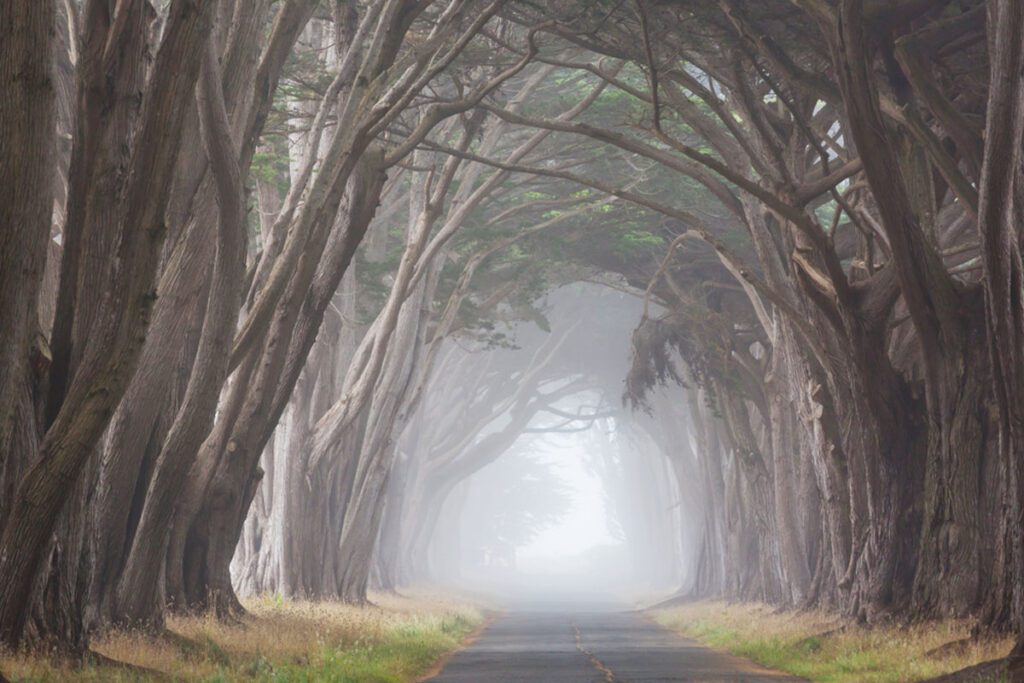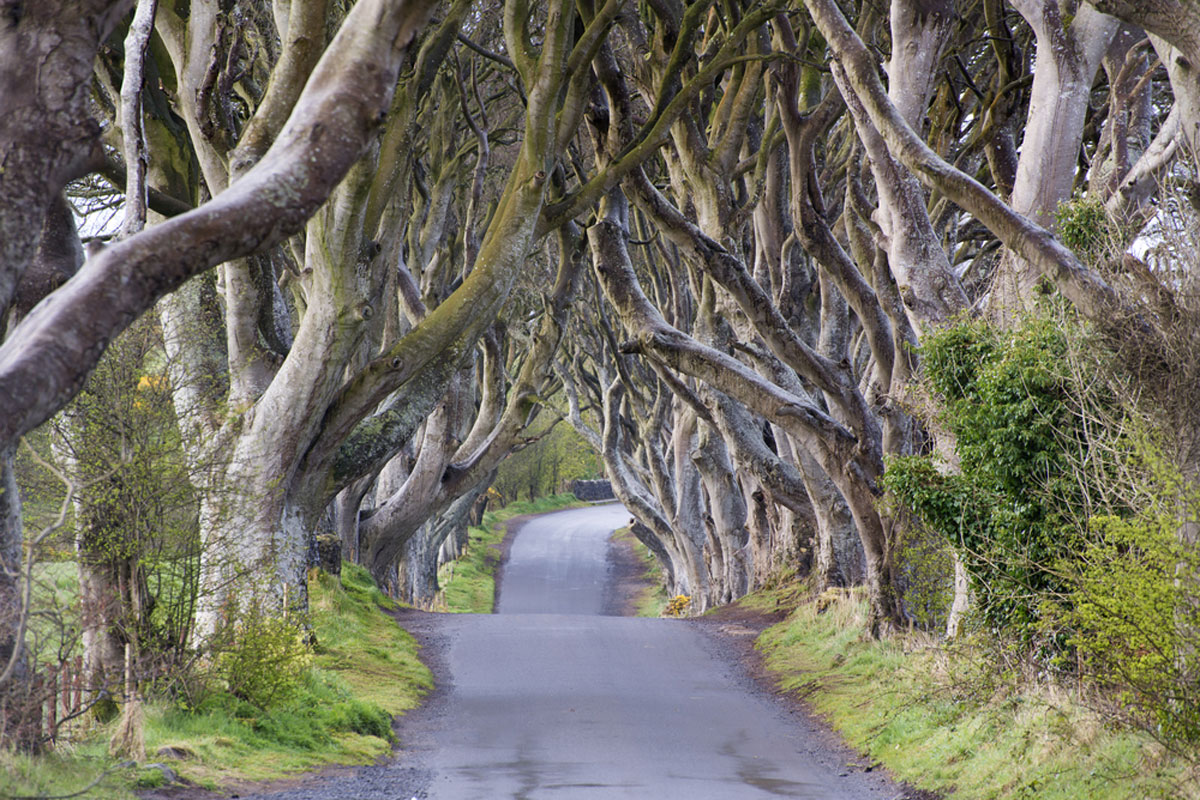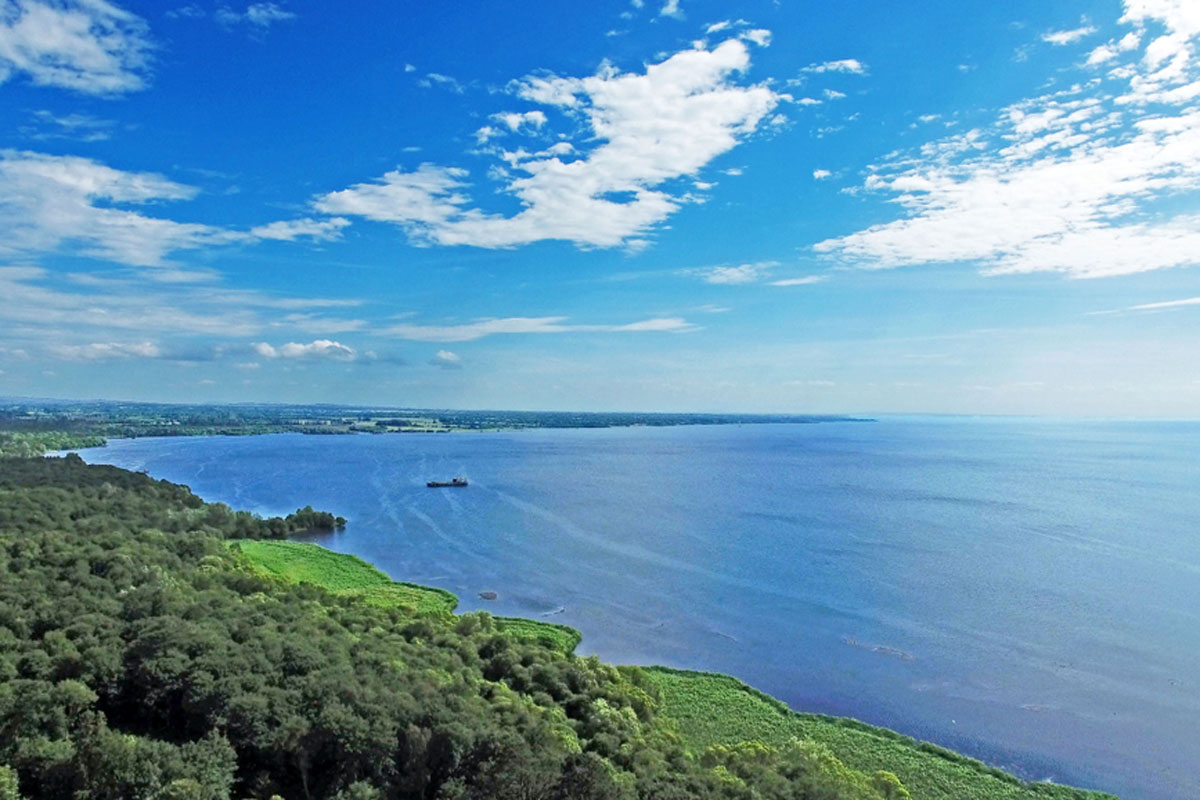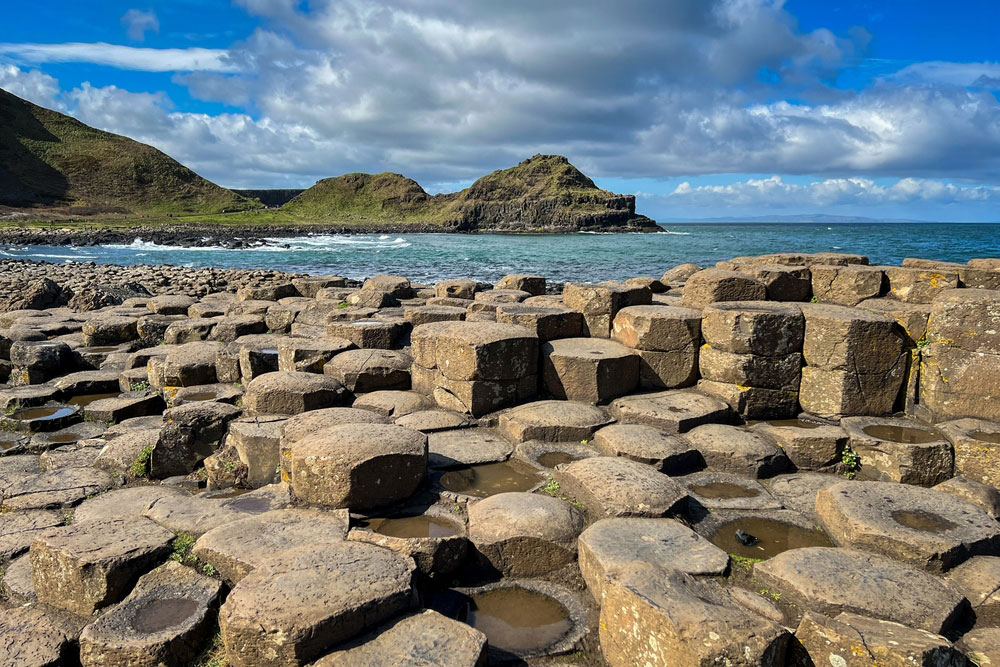The Enigmatic Origins
The Dark Hedges, located in Ballymoney, Northern Ireland, is one of the most photographed natural phenomena in the country. This captivating avenue of beech trees, planted in the 18th century, forms an atmospheric tunnel that has captured the imaginations of locals and tourists alike.
The Origins
The Dark Hedges were planted by the Stuart family in the late 1700s. James Stuart, who had built the nearby Georgian mansion, Gracehill House, wanted an impressive entranceway to his estate. He chose to plant beech trees along both sides of the road, which have since grown and intertwined to form the iconic canopy we see today. The intention was purely aesthetic, designed to impress visitors as they approached the manor.
The Trees
Beech trees were selected for their grandeur and the dramatic effect they could create as they matured. Over the centuries, these trees have grown tall and thick, their branches intertwining above the road, creating an almost otherworldly tunnel. The natural archway formed by the beech trees changes with the seasons, offering a continuously evolving spectacle—from lush green in the spring and summer to a haunting, skeletal appearance in the winter.
Local Legends
The enchanting appearance of the Dark Hedges has given rise to numerous local legends and ghost stories. One of the most famous tales is that of the Grey Lady, a spectral figure said to glide silently along the road beneath the trees. According to the legend, she vanishes as she passes the last beech tree, believed to be a lost soul from a nearby abandoned graveyard. This story, along with the natural beauty of the Dark Hedges, adds an element of mystery and intrigue that attracts visitors from around the world.
Cultural Significance
The Dark Hedges have not only captured local folklore but have also made their mark on popular culture. Most notably, the site was featured as the Kingsroad in the acclaimed television series Game of Thrones. This appearance brought international attention to the Dark Hedges, cementing its status as a must-visit location for fans of the show and photography enthusiasts.
Cultural Significance and Artistic Inspiration
The Dark Hedges have transcended their original purpose as a grand entrance to the Gracehill House estate. Over the years, these beech trees have become a cultural icon, inspiring countless artists, writers, and filmmakers.
Literary Inspirations
The haunting beauty of the Dark Hedges has made it a source of inspiration for many writers. The interplay of light and shadow, the twisted branches, and the serene yet eerie atmosphere provide a perfect backdrop for storytelling. Local legends and ghost stories surrounding the Dark Hedges often find their way into literature, enriching the narratives with a touch of the supernatural. Authors have used the setting to evoke emotions of mystery, suspense, and nostalgia, making the Dark Hedges a recurring motif in Irish literature.
Artistic Renditions
Artists have long been captivated by the ethereal quality of the Dark Hedges. Painters and photographers flock to the site to capture its ever-changing beauty. The interplay of light filtering through the canopy, the textures of the bark, and the seasonal transformations offer endless opportunities for creative expression. The Dark Hedges have been featured in numerous exhibitions and art collections, both locally and internationally, solidifying their place as a significant subject in the world of visual arts.
Music and Performances
The enchanting ambiance of the Dark Hedges has also influenced musicians and performers. The site has been used as a backdrop for music videos, album covers, and live performances, adding a dramatic and mystical element to artistic presentations. Its natural acoustics and visually striking setting make it an ideal location for open-air concerts and theatrical performances, further embedding it in the cultural fabric of the region.
Film and Television
One of the most notable appearances of the Dark Hedges in popular culture is its portrayal as the Kingsroad in HBO’s Game of Thrones. This exposure brought global attention to the site, drawing fans of the show from around the world. The Dark Hedges’ cinematic appeal has made it a sought-after location for filmmakers, contributing to its status as a symbol of Northern Ireland’s rich cultural heritage. Its inclusion in various media productions has boosted tourism, providing economic benefits to the local community while preserving the cultural significance of the site.
Cultural Preservation
The growing fame of the Dark Hedges has led to efforts to preserve its natural beauty and cultural heritage. Local organizations and government bodies have implemented measures to protect the trees from damage due to increased foot traffic and vehicular use. These conservation efforts ensure that the Dark Hedges remain a source of inspiration and cultural significance for future generations. The community’s commitment to preserving the site highlights the deep-rooted connection between the Dark Hedges and the cultural identity of the region.
Ecological Impact and Conservation Efforts
The Dark Hedges, with its hauntingly beautiful canopy and historic significance, has seen a surge in visitors, especially following its appearance in popular media. However, the influx of tourists poses a significant ecological challenge. Let us now delve into the environmental impact of increased tourism and the ongoing conservation efforts to protect this natural wonder.
Ecological Challenges
The Dark Hedges’ beech trees, planted in the 18th century, were not initially intended to withstand the pressures of modern tourism. The delicate root systems of these ancient trees are particularly vulnerable to soil compaction caused by the constant flow of visitors and vehicles. Over time, this compaction can lead to reduced oxygen and water availability for the roots, weakening the trees and making them more susceptible to disease and decay.
Erosion and Soil Degradation
Increased foot traffic has also led to erosion along the pathways, further destabilizing the soil and the trees. The natural landscape surrounding the Dark Hedges has experienced significant wear and tear, affecting not only the trees but also the surrounding flora and fauna. Erosion can alter the natural drainage patterns, leading to increased runoff and potential flooding, which can further stress the trees.
Conservation Initiatives
Recognizing the urgent need to protect the Dark Hedges, local authorities and environmental organizations have implemented several conservation measures. One of the primary steps taken has been the restriction of vehicle access along Bregagh Road, the main pathway through the Dark Hedges. By limiting vehicular traffic, the risk of soil compaction and root damage has been significantly reduced.
Pathway Restoration
Efforts have also been made to restore the eroded pathways. By installing boardwalks and designated walking paths, the movement of visitors can be better controlled, minimizing direct impact on the soil and tree roots. These pathways are designed to blend with the natural landscape, preserving the aesthetic appeal of the Dark Hedges while protecting the underlying ecosystem.
Educational Programs
Raising awareness about the ecological significance of the Dark Hedges and the importance of conservation has been a key focus of local initiatives. Educational programs and guided tours help visitors understand the delicate balance required to maintain this historic site. By promoting responsible tourism practices, these programs encourage visitors to appreciate and protect the natural beauty of the Dark Hedges.
Tree Health Monitoring
Regular monitoring of tree health is essential to the long-term preservation of the Dark Hedges. Arborists and conservationists conduct periodic assessments to identify signs of disease, pest infestations, and structural weaknesses. These assessments guide targeted interventions, such as pruning, pest control, and soil treatments, to enhance the trees’ resilience and longevity.
Community Involvement
The local community plays a crucial role in the conservation efforts. Volunteer groups and community organizations actively participate in clean-up drives, tree planting initiatives, and awareness campaigns. Their involvement fosters a sense of stewardship and collective responsibility for the preservation of the Dark Hedges.
Balancing Tourism and Conservation
Finding the right balance between promoting tourism and ensuring the conservation of the Dark Hedges is an ongoing challenge. Sustainable tourism practices, such as limiting visitor numbers and promoting off-peak visits, are being explored to reduce the environmental footprint. Additionally, revenue generated from tourism is being reinvested into conservation projects, ensuring that the economic benefits support the long-term health of the site.

Myths and Legends
The Dark Hedges, with its ethereal canopy and ancient trees, is not just a natural marvel; it is also a place steeped in folklore and legends. Myths and stories have shrouded the Dark Hedges in mystery, adding to its allure and captivating the imaginations of visitors for generations.
The Grey Lady
One of the most enduring legends associated with the Dark Hedges is that of the Grey Lady. According to local lore, a spectral figure is said to haunt the road, gliding silently beneath the intertwining branches. She is often described as a young woman dressed in a long, grey cloak, with a sorrowful expression on her face. Some say she is the ghost of a maid from a nearby house who died tragically, while others believe she is a lost spirit from an ancient burial ground hidden among the trees. Witnesses claim she disappears as soon as they approach her, vanishing into the twilight.
The Phantom Coach
Another popular legend involves a phantom coach that is said to travel along the road under the cover of darkness. Pulled by invisible horses and driven by a headless coachman, this eerie apparition is often heard more than seen. The sound of galloping hooves and the creaking of wooden wheels echo through the night, sending shivers down the spines of those who hear it. Some locals believe that this ghostly carriage is a harbinger of misfortune, while others see it as a spectral remnant of the Hedges’ aristocratic past.
The Curse of the Stuart Family
The Stuart family, who originally planted the beech trees in the 18th century to impress visitors to their Gracehill House estate, are also central to the folklore of the Dark Hedges. It is said that a curse was placed upon the family, ensuring that any male heir who witnessed the Grey Lady would meet an untimely death. This curse was purportedly invoked by a disgruntled servant or a spurned lover, and the Stuart family’s fortunes did decline over the years. The legend of the curse adds a layer of intrigue to the already mysterious atmosphere of the Dark Hedges.
The Wishing Tree
Amidst the spooky tales, there is also a more hopeful legend associated with the Dark Hedges: the Wishing Tree. According to tradition, one of the ancient beech trees possesses magical properties and can grant wishes to those who place their hand on its trunk and make a heartfelt request. Locals and visitors alike have been known to seek out this tree, hoping that their wishes for love, health, or prosperity will be fulfilled. While the exact identity of the Wishing Tree remains a secret, the legend continues to attract those in search of a little magic in their lives.
Literary Inspirations
The Dark Hedges have also found their way into literature, inspiring writers and poets with their haunting beauty and mystical aura. The intertwining branches and shifting shadows provide a perfect backdrop for tales of mystery and romance. Irish authors, in particular, have drawn upon the Hedges in their works, weaving the legends into their narratives and further embedding the site in the cultural imagination. These literary references help to preserve and propagate the myths, ensuring that the stories of the Dark Hedges live on.
Cultural Significance
The myths and legends of the Dark Hedges are more than just spooky stories; they are a testament to the cultural significance of the site. These tales connect the present with the past, offering a glimpse into the lives and beliefs of those who came before us. They also serve as a reminder of the power of storytelling and the ways in which places can become imbued with meaning through the stories we tell.
Artistic Representations
The Dark Hedges, with its natural beauty and atmospheric charm, has long been a muse for artists across various mediums. Painters, photographers, and filmmakers have captured the essence of this enchanting location, contributing to its mystique and popularity.
Painters and Illustrators
The unique, haunting beauty of the Dark Hedges has inspired countless painters and illustrators. The twisted, gnarled branches of the beech trees create a natural tunnel that provides a dramatic focal point for landscape art. Artists are drawn to the interplay of light and shadow that the canopy creates, capturing the ethereal quality of the place on canvas. The moodiness and timelessness of the Hedges make it an ideal subject for those seeking to evoke emotion and wonder through their art. From oil paintings to watercolors, the Dark Hedges have been depicted in various styles, each artist bringing their own interpretation to the iconic site.
Photographers
Perhaps more than any other medium, photography has played a significant role in bringing the Dark Hedges to the attention of the world. The picturesque avenue of beech trees, particularly in the soft light of dawn or the golden hour of sunset, creates stunning photographic opportunities. Photographers often seek to capture the fog that sometimes blankets the Hedges, adding a layer of mystery and magic to their images. These photographs are widely shared on social media and featured in travel magazines, helping to cement the Dark Hedges as one of Ireland’s must-visit locations. The vivid, almost otherworldly images that photographers produce have been instrumental in showcasing the beauty and mystique of the Hedges to a global audience.
Filmmakers and Television
The Dark Hedges gained international fame when it was featured as a filming location in the popular television series “Game of Thrones.” The avenue served as the Kingsroad, one of the most iconic thoroughfares in the fictional land of Westeros. This exposure introduced the Dark Hedges to millions of viewers worldwide, sparking a surge in tourism and interest in the site. Filmmakers are drawn to the Hedges not only for its aesthetic appeal but also for its atmospheric qualities, which provide an ideal setting for scenes that require a sense of mystery and enchantment. The use of the Dark Hedges in film and television has solidified its status as an iconic location, blending the lines between reality and fantasy.
Writers and Poets
The Dark Hedges have also found their way into literature, serving as inspiration for writers and poets. The haunting beauty and legends surrounding the Hedges provide a rich backdrop for storytelling. Irish authors, in particular, have incorporated the Hedges into their works, weaving its mysterious ambiance into their narratives. Whether as a setting for a romantic rendezvous, a place of supernatural occurrences, or a symbol of nature’s enduring power, the Dark Hedges continue to inspire literary creativity. The site’s appearance in poetry often highlights its ephemeral beauty and the sense of nostalgia it evokes, capturing the imagination of readers.
Modern Interpretations
In addition to traditional art forms, the Dark Hedges have also inspired modern interpretations through digital art and installations. Artists use technology to create virtual tours and interactive experiences that allow people from around the world to explore the Hedges from the comfort of their homes. These modern representations help to keep the site relevant and accessible, ensuring that the magic of the Dark Hedges continues to reach new audiences. Digital artists and virtual reality developers have created immersive experiences that replicate the feeling of walking beneath the canopy of ancient trees, making the Dark Hedges accessible to those who may never have the chance to visit in person.
Cultural Impact
The artistic representations of the Hedges have had a profound impact on its cultural significance. Through paintings, photographs, films, and literature, the Hedges have transcended their physical location to become a symbol of Ireland’s natural beauty and rich heritage. These artistic works not only preserve the image of the Hedges for future generations but also enhance its allure and mystique. The Dark Hedges have become a cultural icon, representing the intersection of nature, art, and storytelling.
The Dark Hedges, with their eerie beauty and rich history, offer a unique glimpse into the captivating blend of natural wonder and cultural heritage that defines Northern Ireland. As we explored the mysteries surrounding these ancient trees, from their creation to their role in popular culture and the supernatural tales they inspire, it’s clear that the Dark Hedges are more than just a picturesque landscape. They are a testament to the timeless allure of nature’s artistry and the enduring power of human imagination. Whether you’re a history enthusiast, a nature lover, or a curious traveler, the Dark Hedges promise an unforgettable journey into the heart of Northern Ireland’s mystical charm.
Natural Wonders
- The Giant’s Causeway – A UNESCO World Heritage Site featuring unique hexagonal basalt columns.
- Carrick-a-Rede Rope Bridge – A thrilling rope bridge linking the mainland to a small island.
- Cushendun Caves – Stunning caves featured in Game of Thrones.
- Glens of Antrim – A series of nine beautiful glens offering breathtaking scenery and walking trails.
- Fair Head – A dramatic cliff with incredible views, popular for hiking and rock climbing.
Castles and Historic Sites
- Dunluce Castle – A medieval castle perched on a dramatic cliff overlooking the sea.
- Carrickfergus Castle – A well-preserved Norman castle dating back to the 12th century.
- Shane’s Castle – A historic estate with a ruined castle and stunning grounds.
Coastal Attractions
- The Dark Hedges – A hauntingly beautiful avenue of beech trees featured in Game of Thrones.
- Ballycastle Beach – A scenic spot for relaxation and views of Rathlin Island.
- White Park Bay – A picturesque beach with stunning coastal views.
Islands and Marine Attractions
- Rathlin Island – Known for its wildlife, seabird colonies, and the Rathlin West Light Seabird Centre.
- Ballintoy Harbour – A charming harbor and filming location for Game of Thrones.
Museums and Cultural Sites
- Ulster Folk and Transport Museum – Showcasing traditional Irish heritage and transportation history.
- Belfast Lough – Known for maritime heritage, including the Titanic Quarter.
Scenic Drives and Routes
- Causeway Coastal Route – A stunning drive featuring some of Northern Ireland’s most iconic attractions.
- Slemish Mountain – Said to be the first home of Saint Patrick in Ireland, popular for hiking.
Unique Experiences
- Old Bushmills Distillery – One of the oldest whiskey distilleries in the world, offering tours and tastings.
- Glenarm Castle and Gardens – A stunning estate with historic gardens and seasonal events.
These attractions make County Antrim a must-visit destination for nature lovers, history buffs, and adventure seekers alike.
Helpful Resources









